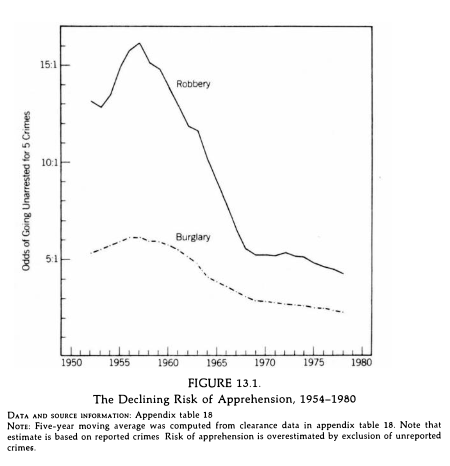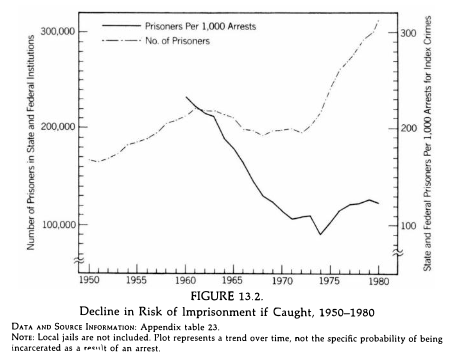This week’s reading takes us back to Losing Ground by Charles Murray. While the opening chapters bordered on the ridiculous in their cherry picking of facts, avoidance of sources and generally fallacious arguments, these final chapters were particularly frustrating. Surely conservative thinkers have a stronger argument to make than Murray’s. I’ve decided to think of this series of posts as “Reading, so you don’t have to.”
 It is unlikely one will find a graph axis label that gives the appearance of saying much while, in reality, saying so little as the vertical label Murray includes on page 168, “Odds of Going Unarrested for 5 Crimes.” It acts as a suitable metaphor for the contents of the chapter.
It is unlikely one will find a graph axis label that gives the appearance of saying much while, in reality, saying so little as the vertical label Murray includes on page 168, “Odds of Going Unarrested for 5 Crimes.” It acts as a suitable metaphor for the contents of the chapter.
The second graph on page 169 presents readers with an even more confusing story. Within the text, Murray points to the span between 1961 and 1969 as particularly unsettling because the number of incarcerated citizens fell so sharply. He fails to mention or find any problem with the soaring incarceration rates beginning in the early 70s.[1]
Murray implies throughout the opening of this chapter that police stopped arresting criminals and that crime rates were skyrocketing. In looking closely, his only mention of actual crime rates comes not from national statistics, but within Cook County, IL. Even then, Murray is making mention not of an actual increase in number of crimes, but concerns himself with juvenile crime (in this one county) “entering its highest rate of increase” (p.170). His conclusion that no reason existed not to commit delinquent acts in the 1970s is a strange one. Murray needed only look at his own graph to see the youth he mentions standing on the street corner had a fairly likely chance of knowing someone who had been arrested and imprisoned for committing a crime.
When turning his attention to education, Murray continues his focus on punishments and sanctions. His description of the frustrations inherent in working in schools with students from varied backgrounds was not incorrect. Students with little support from home present special challenges for learning. These are challenges that often require new approaches to teaching. Murray, once again assumes an external locus of control. This is not surprising, considering his application of such a theory to people living in poverty, those considering criminal activity, and Harold & Phyllis’ decision of whether or not to go on welfare. Children, like the adults Murray considers, are to be considered as driven solely by external forces.
Suspensions and expulsions, Murray reasons were key tools in helping students learn. Those who found themselves suspended had made their choice, and rejected the opportunity to learn. In defending these tools, Murray again ignores race and shows no signs of awareness of or interest in the school-to-prison pipeline[2] that was developing in America at the time. Further, in his dismissal of African American efforts to shift schooling for their children, Murray shows an ahistorical understanding of the goals and work of those schools as we discussed in class.
Murray’s main argument about education (that the inclusion of disinterested students who would otherwise have found themselves suspended or expelled destroyed the learning of interested students and lowered the standards of teachers) comes not surprisingly without evidence to support his claims. More frustrating is Murray’s lack of interest in changing what was going on inside of schools rather than kicking students out of them. He appears to be making a “business as usual” argument that education would have been fine if we could have kept the bad kids out. Again, this shows a lack of consideration of the ways in which the world was changing during the 60s and 70s. Murray would have done well to consider the idea that the misalignment of the world within the classroom with the world outside the classroom might have had more to do with a lack of student interest than the removal of the “bad” students.
One final note about this chapter, on page 177, Murray writes, “For blacks, the uncertainty and distance of the incentive have been compounded by discrimination that makes it harder to get and hold jobs.” Here, the emotional baggage of race in America moves to support his purpose and is picked up again. It raises the question of whether Murray ignored race in the previous chapter because it could muddy the clarity he found in his argument about welfare incentives.
[1] This is to say nothing of the abhorrent design of the graph.
[2] As documented by the Juvenile Justice Project of Louisiana – http://jjpl.org/suspensions-matter/
